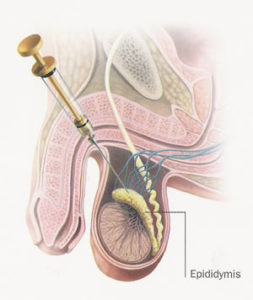Sperm retrieval
Normally sperm are produced in a region of the testes called the seminiferous tubules and are then stored in a region known as the epididymis where they mature. At the time of ejaculation they travel up a tube known as the vas deferens (this is the tube that is cut during vasectomy) and are mixed with excretions which mainly originate in the prostate, seminal vesicles and bulbourethral glands before being ejaculated as semen.
In some individuals sperm cannot reach the semen because there is a blockage somewhere in the testicle or part of one area is absent or abnormal. In cases such as this the diagnostic semen analysis will show that there were no sperm present: this is known as Azoospermia.
In such cases sperm can be artificially removed from the area situated directly before the blockage. Sperm recovered from the testes in this manner are less mature than those normally found in semen because they have had less time to develop. They are usually not capable of fertilising an egg naturally. For this reason the sperm will be used in conjunction with ICSI (intra-cytoplasmic sperm injection). Find out more on the ICSI page.
Sperm recovery procedures
There are several sperm recovery procedures: they are all minor operations and include:
1. PESA- percutaneous epididymal sperm aspiration
A fine needle is passed through the skin of the scrotum and into the epididymal region of the testes. Sperm are drawn off and used in the ICSI procedure. This procedure is carried out under local anesthetic.
2. TESA- testicular sperm aspiration
This is used if PESA is unsuccessful or not possible. The needle is inserted in a lower region of the testes and a small piece of testicular tissue is removed. This may be carried out at a number of different sites on the testes to collect sufficient sperm. This procedure is carried out under local anaesthetic.
3. TESE- testicular sperm extraction
This is used if PESA or TESA are unsuccessful or not possible.
TESE involves the removal of some tissue from the testicle either by open operation (under sedation) or using a biopsy needle (local anesthetic). This tissue is then examined in the laboratory for the presence of sperm.
4. MESA- micro epididymal sperm aspiration
This technique uses a small needle to aspirate relatively mature sperm from the epididymis and is suitable for patients who have a blockage or absence of the vas deferens. It is an open procedure and is therefore only attempted in theatres under sedation. Usually MESA is attempted at the same time as another procedure such as vasectomy reversal.
Preparing for the operation
You would be required to trim your scrotum the night before the operation and eat nothing for 6 hours prior to treatment.
After the operation
MESA and sometimes TESE are carried out under sedation whereas PESA, TESA and usually TESE only require a local anaesthetic. After the procedure you will require transport and should not drive or work for at least 24 hours. There will be some minor bruising and swelling and a little discomfort for a few days after the procedure.
Sperm collection, use and storage
The sperm collection itself will be co-ordinated so that it coincides with your partner’s egg recovery in the ICSI cycle, or if sufficient good quality sperm are retrieved, your sperm will be frozen in liquid nitrogen and can then be thawed out and used at any convenient time. The maximum period that sperm recovered from the testis can be stored is 10 years if over 45 or until the age if 55 if under 45, in cases where sperm function is likely to be permanently impaired.
It is important to note that if sperm is frozen its quality will be impaired on thawing. There is a small chance that no sperm will survive the freezing process. Find out more on the Sperm Storage page.
